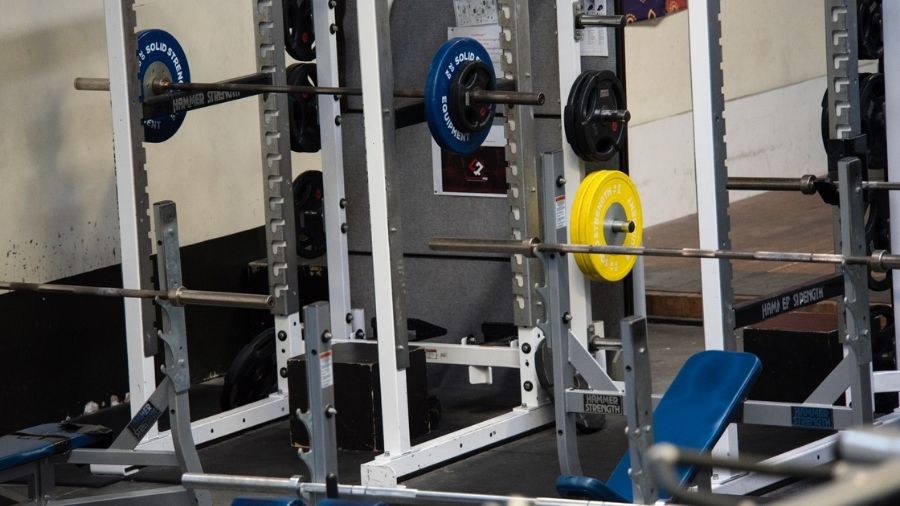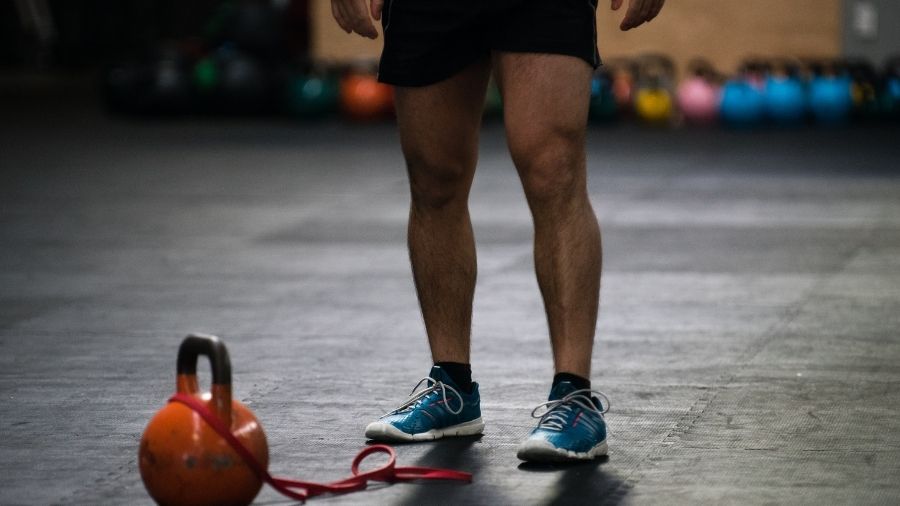If you’re wondering if you should do a full body vs. split routine for your next training cycle, then look no further. I’ve broken down everything you need to know about each workout split.
Full body workouts are great for beginner lifters and strength development whereas split routines may be better for muscle growth.
While this is a quick answer to the full body vs. split routine debate, there is much more nuance to it and you may be surprised to know that both routines can be beneficial for many different goals.
Table of Contents
- Full Body Workout Benefits
- Full Body Workout Cons
- Split Workout Benefits
- Split Workout Cons
- Example Full Body Workouts
- Example Split Workouts
- Should You Use A Full Body Or Split Workout?
- Full Body vs. Split Workouts For Strength
- Full Body vs. Split Workouts For Mass
- Full Body vs. Split Workouts For Fat Loss
- Full Body vs. Split Workouts For Beginners
- When To Switch From Full Body To Split?
- Full Body vs. Split Summary
Full Body Workout Benefits
Time Efficient
One of the main reasons people are drawn to full body workouts is training efficiency. Because you are training the whole body, you can workout less often and get more done within a single session. Most full body routines are three days per week programs allowing plenty of time for other activities you enjoy.
Focuses On Big Compound Lifts
Because you are training the whole body in one workout, you can’t waste your time with various isolation exercises otherwise your session would be too long. For example, performing the back squat, bench press, and barbell row cover most of your body in three exercises.
If you have time, you could finish with some isolation exercises as you see fit but the bulk of the work has been done. By forcing you to prioritize big compound lifts, you will see huge progress in strength and size. When you’re only performing a few sets for each exercise, an isolation approach wouldn’t be the best use of time.
Keeps Training Exciting
Do you have that one body part you hate to train? The joke is often that lifters will skip leg day because they don't like training legs. But if you're performing a full body workout, you know that you only have a few sets of legs before you can blast the upper body. This will keep your overall strength and physique development balanced.
Increased Training Frequency
A full body workout three times per week means you are training most muscle groups 2-3 times per week. Depending on the split routine, you may only train a muscle group 1-2 times per week. While the number of times you train a muscle group doesn't inherently dictate muscle growth, volume does, and being able to train a muscle more times per week can lead to increased training volume [1].
Interestingly, recent research has suggested that full body routines may be superior for strength development due to this increased training frequency [2].
Better For Sports Performance
Generally, a full body routine is going to be better for sports performance. It doesn’t allow for so much local fatigue which can negatively impact sports training while being able to develop full body strength and power.
That’s if we compare it to a typical hypertrophy bro split. Some split routines can be used with great success with athletes such as the upper/lower split routine.
Full Body Workout Cons

Difficult To Push To Failure
The fatigue that occurs as we lift close to or at failure is a key requisite for building muscle [3]. Because you are training most muscle groups every session, pushing to the point of failure or extreme fatigue can hinder your next workout as you need to perform similar exercises that hit the same muscle groups.
Difficult To Train More Often
Unless very well planned, full body routines generally don’t exceed three times per week of training. A fourth day can often be added of bodybuilding type exercises to spur extra muscle growth but if you are squatting, deadlifting, and performing other upper body exercises heavily, then it is already very taxing.
If you can undulate your days where you alternate heavy and light days, you may be able to train more often. Is this more effective than sticking to the three heavy days? Only you'll know for yourself if you experiment.
Split Workout Benefits
Can Easily Allow Specialization
Body part specialization routines aren’t new to the physique development or bodybuilding space. They are often employed by the old-time strongmen back before the steroid era. Some of the strongest individuals in the world used them.
Split routines allow you to specialize certain body parts that may be lagging in your physique. For example, a chest specialization could mean you train the chest with 2-3 workouts per week while the back, legs, and shoulders only get one workout per week.
Greater Muscular Fatigue
While this is a con of full body workouts, this is a big win for split workouts. You can perform more volume per muscle group and lift closer to failure in each workout meaning a greater muscle-building response.
The reduction in lifting velocity as you fatigue is a key indicator that signals a hypertrophy response.
More Exercise Variety
Because you are only training one or two muscle groups per workout, you have many exercises to choose from. For example, if it is a back day, you have all kinds of various pulldowns, rows, and even machine-based exercises to maximize your training session.
This allows you to train the muscle from different angles, with different rep ranges, and with different loads in a single workout.
Workout More Often
If you don't like hitting the gym, then this is a con. But most lifters running a split workout love to lift weights. So, this allows them to be in the gym more often. Because muscle groups are trained at least three days apart, you have plenty of recovery time.
Split Workout Cons

Overemphasis Of The Upper Body
Most split routines only train the legs once per week. Some are more generous and will prioritize the quads in one workout and the hamstrings in another. But overall, the majority of the time is spent training the upper body.
If that is your goal, great. But most lifters are looking for complete physique development and may want to alter their split routine to reflect that.
Time Consuming
If you work a full-time job, have a family, or have other hobbies you're interested in, it doesn't make much sense to run a six-day per week split routine. You won't have time for any other activities. This is why full body workouts are generally better suited to these individuals.
Example Full Body Workouts
The simplest way to create a full body routine is to follow this simple formula:
That is the meat and potatoes of your full body routine. If adding a fourth day, this should be using mainly isolation exercises that you don’t have time for during normal training sessions that don’t affect recovery for the following week. Here is an example of a 3 and 4-day full body routine.
3-Day Full Body Workout
Monday
Exercise | Set/Rep | Load |
|---|---|---|
A1) Back Squat | 4 x 5 | 75% 1RM |
B1) Bench Press | 4 x 5 | 75% 1RM |
B2) Pull-Up | 4 x 5-10 | 8 RPE |
C1) Seated Leg Curl | 3 x 10-15 | 9 RPE |
C2) Hanging Leg Raise | 3 x 10 | 9 RPE |
Wednesday
Exercise | Set/Rep | Load |
|---|---|---|
A1) Deadlift | 4 x 4 | 80% 1RM |
B1) Overhead Press | 4 x 6 | 75% 1RM |
B2) Barbell Row | 4 x 8 | 8 RPE |
C1) Bulgarian Split Squat | 3 x 10-15/leg | 9 RPE |
Friday
Exercise | Set/Rep | Load |
|---|---|---|
A1) Front Squat | 4 x 5 | 75% 1RM |
4 x 6 | 75% 1RM | |
B2) Lat Pulldown | 4 x 10 | 8 RPE |
C1) Back Extension | 3 x 10-15 | 9 RPE |
C2) Incline Crunch | 3 x 10 | 9 RPE |
4-Day Full Body Workout
Monday
Exercise | Set/Rep | Load |
|---|---|---|
A1) Back Squat | 4 x 5 | 75% 1RM |
B1) Bench Press | 4 x 5 | 75% 1RM |
B2) Pull-Up | 4 x 5-10 | 8 RPE |
C1) Seated Leg Curl | 3 x 10-15 | 9 RPE |
C2) Hanging Leg Raise | 3 x 10 | 9 RPE |
Wednesday
Exercise | Set/Rep | Load |
|---|---|---|
A1) Deadlift | 4 x 4 | 80% 1RM |
B1) Overhead Press | 4 x 6 | 75% 1RM |
B2) Barbell Row | 4 x 8 | 8 RPE |
C1) Bulgarian Split Squat | 3 x 10-15/leg | 9 RPE |
Friday
Exercise | Set/Rep | Load |
|---|---|---|
A1) Front Squat | 4 x 5 | 75% 1RM |
B1) Incline Bench Press | 4 x 6 | 75% 1RM |
B2) Lat Pulldown | 4 x 10 | 8 RPE |
C1) Back Extension | 3 x 10-15 | 9 RPE |
C2) Incline Crunch | 3 x 10 | 9 RPE |
Saturday
Exercise | Set/Rep | Load |
|---|---|---|
A1) Lateral Raise | 4 x 15 | 8 RPE |
A2) Rear Delt Fly | 4 x 20 | 8 RPE |
B1) Cable Triceps Extension | 4 x 10-15 | 9 RPE |
C1) Barbell Curl | 4 x 8 | 9 RPE |
D1) Lying Triceps Extension | 3 x 10-15 | 9 RPE |
D2) DB Bicep Curl | 3 x 10-15 | 9 RPE |
Example Split Workouts
There are multiple ways you can use the split routine.
If your goal is strength-based, then an upper/lower split is best to use. If your goal is hypertrophy, then bro splits or push pull legs routines are your best options. Here are some split examples:
4-Day Upper/Lower Split Routine
Monday: Lower (Quadriceps Emphasis)
Tuesday: Upper (Vertical Emphasis)
Wednesday: OFF
Thursday: Lower (Hamstrings Emphasis)
Friday: Upper (Horizontal Emphasis)
By splitting your upper body into vertical and horizontal instead of pushing and pulling, you get to train all of the upper body muscles twice a week.
5-Day Bro or Body Part Split
Monday: Chest & Triceps
Tuesday: Back & Biceps
Wednesday: Shoulders & Abs
Thursday: Legs
Friday: Chest & Back
This is just one example. You can easily change this and perform two leg workouts or even two back workouts. If big arms were your goal, then you can even add an arm day instead of the chest and back day.
6-Day Push Pull Legs Routine
Monday: Push (Chest Emphasis)
Tuesday: Pull (Vertical Emphasis)
Wednesday: Legs (Quadriceps Emphasis)
Thursday: Push (Shoulders Emphasis)
Friday: Pull (Horizontal Emphasis)
Saturday: Legs (Hamstrings Emphasis)
Again, just because it is a vertical or horizontal emphasis doesn’t mean you only perform pulldowns or rows. It means you perform the main emphasis for that day first in the workout along with 2-3 other exercises in the same plane of movement. Then you may finish the workout with the other plane of movement.
Should You Use A Full Body Or Split Workout?

There are so many factors to consider when choosing a full body vs. split workout routine. The time you have to train and your training goals are the two main factors that will dictate which you choose. So, I’ll break down each goal below!
Full Body vs. Split Workouts For Strength
For strength, you can use either full body or split routines effectively. However, with the split routine, only the upper/lower split should be used in my experience. For example, the split could look like this:
Day 1: Lower (Squat Day)
Day 2: Upper (Bench Day)
Day 3: Lower (Deadlift Day)
Day 4: Upper Body Hypertrophy Day
This tends to work best as a split routine for strength. Full body routines are also very effective like the routine I posted above in the example full body workout section.
Full Body vs. Split Workouts For Mass
Both the full body and split routines can be used for packing on mass. However, split routines are generally superior for this goal compared to full body. For example, one research study found split routines to induce better muscle growth outcomes [2].
However, this doesn’t seem to fall in line with previous research stating that training frequency doesn’t influence muscle growth when the volume is equated [4]. Although, increasing training frequency can be an easy tactic to increase training volume when needed.
Further, split routines allow for greater fatigue and metabolite build-up (aka metabolic stress) which directly influences muscle growth [5].
Full Body vs. Split Workouts For Fat Loss
While you can easily use both full body or split workouts for fat loss, I give the edge to split routines. Why? Because lifting weights for fat loss isn’t about burning lots of calories. Or spiking your heart rate into the red zone leaving you in a pool of sweat on the floor.
The gym is for retaining as much muscle mass as possible. Undertaking hypertrophy-style routines are what will do that. You need adequate stimulus to tell your body it needs to keep muscle while you eat at a caloric deficit. This way, you primarily lose body fat with only a little muscle mass instead of losing both creating a skinny fat look.
Full Body vs. Split Workouts For Beginners
For beginners, full body routines are best. It allows them greater frequency to practice exercises and learn the movements and because beginners can't express high force outputs, fatigue and soreness aren't so much of an issue leading to fast recovery.
When To Switch From Full Body To Split?

There is no hard and fast rule to switch from a full body to a split routine. Some lifters may stay performing full body routines for years. Others may look to change to a split routine earlier in the quest for greater muscle gains.
If your goal is strength development, ride the full body routine until you decide to compete or specialize. For those seeking physique development, once you’ve gained some basic strength and locked in a training routine, start by adding an extra day of training.
Then start to look at an upper/lower split while still prioritizing the big compound lifts to get stronger. There is no point changing to a bro split and being weak. The poundage you'll be using for isolation exercises isn't heavy enough to turn you into a monster. Getting stronger will help you grow as you'll be able to use heavier weights for all exercises.
Full Body vs. Split Summary
Trial and error will help you find which type of training routine you like best. Full body routines may be better for beginners and those that are conscious of training time whereas split routines might be better for developing muscle mass.
Overall, the full body vs. split routine debate often comes down to personal preference. I would recommend trying them all at some point within your lifting career!
References
1. Schoenfeld, B. J., Ogborn, D., & Krieger, J. W. (2017). Dose-response relationship between weekly resistance training volume and increases in muscle mass: A systematic review and meta-analysis. Journal of sports sciences, 35(11), 1073-1082.
2. Bartolomei, S., Nigro, F., Lanzoni, I. M., Masina, F., Di Michele, R., & Hoffman, J. R. (2021). A comparison between total body and split routine resistance training programs in trained men. The Journal of Strength & Conditioning Research, 35(6), 1520-1526.
3. Schoenfeld, B. J. (2010). The mechanisms of muscle hypertrophy and their application to resistance training. The Journal of Strength & Conditioning Research, 24(10), 2857-2872.
4. Grgic, J., Schoenfeld, B. J., Davies, T. B., Lazinica, B., Krieger, J. W., & Pedisic, Z. (2018). Effect of resistance training frequency on gains in muscular strength: a systematic review and meta-analysis. Sports Medicine, 48(5), 1207-1220.
5. Schoenfeld, B. J. (2013). Potential mechanisms for a role of metabolic stress in hypertrophic adaptations to resistance training. Sports medicine, 43(3), 179-194.
